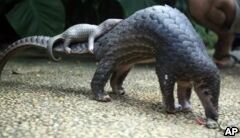正文
Wildlife Convention Protects Animals Great and Small(翻译)
Delegates from around the world met this week in Johannesburg, South Africa to discuss how to stop the trade in endangered animals.
Representatives from 183 countries attended the Convention on International Trade of Endangered Species conference, known as CITES.
The delegates discussed about 500 animals. The pangolin, or scaly anteater, was among them.
Pangolins are mammals found in Asia, India and Africa. They eat insects. Hunters catch pangolins and sell them for their meat and their scales. Some cultures believe the scales can be used in medicine.
They are the most illegally traded animal in the world.

While CITES often deals with the protection of large animals like big cats, elephants and rhinoceroses, it also pays attention to smaller animals.
One of the first agreements to come from the convention was to reclassify all eight species of pangolins. They are now in the most protected group of animals. This means the CITES considers them in danger of extinction.
John Scanlon is the CITES Secretary General. He said they used to call the pangolin “little-known.” But in recent years, Prince William spoke out against the pangolin trade.
Scanlon said he is pleased a famous person brought attention to the pangolin. But he noted that there are still hundreds of small, unknown animals that need help.
“But, we’ve got the snakes here, we’ve got the lizards here, we’ve got the frogs here. And some really interesting ones, the earless monitor [lizard], the Titicaca frog, the psychedelic rock gecko; there are some really interesting animals there that nobody’s paid much attention to.”
Dan Ashe is the director of the U.S. Fish and Wildlife Service. He said it is hard to make people aware of strange animals.
“We’re dealing with things like the Delhi Sands flower-loving fly or the Houston toad. These are things which often the public questions, ‘why is this important, why should we save this?"
Jen Creamer is president of Animal Defenders International. She said even a cockroach has a “strange sort of beauty.” Events like CITES provide the chance for discussion of all sorts of animals.
“With certain species it takes time to realize that they’re in trouble.”
One of the species Ashe is happy to see thriving is a small fish called the Oregon chub. It took nearly 20 years to bring the fish’s population back to strong levels.
The Titicaca water frog is another endangered animal that could use the support of a prince, or even a movie star. The Peruvian animal faces the threat of fungal infection and predatory fish.
I’m Christopher Jones-Cruise.
Anita Powell wrote this story for hxen.net. Dan Friedell adapted it for Learning English. Caty Weaver was the editor.
What do you think of the efforts to protect these animals? We want to know. Write to us in the Comments Section or on our www.hxen.net .
相关文章
- "Me and My Friends"是否违反了语法规则?
- If and Whether, Part 2
- If and Whether, Part 1
- 'The Caliph, Cupid and the Clock,' by O. Henry
- 'Mammon and the Archer' by O. Henry
- Intonation, Speaking and Grammar
- 'The Return of a Private' by Hamlin Garland
- Poetry Collection Brings Together Writings about Pandemic
- Young Climate Activists Work Around Pandemic Limitations
- Advice, Modals, and Coronavirus




 手机网站
手机网站